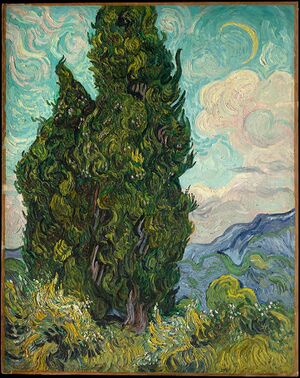Impressionism
Impressionism was a major movement , that developed mainly in France during the late 19th and early 20th centuries. It comprises the work produced between about 1867 and 1886 by a group of artists who shared some related approaches and techniques. The most notable characteristic of Impressionism in painting was an attempt to record visual reality in terms of of light and colour, usually throgh blurred and abstract images.
Painting
The term 'Impressionist' was first used as an insult in response to an exhibition of new paintings in Paris in 1874. A diverse group of painters, rejected by the art establishment, defiantly set up their own exhibition. They included Monet, Renoir, Pissarro and Degas.What characterises Impressionism for most people nowadays, is both the subject matter and the technique. Landscapes, and scenes from modern urban and suburban life painted in bright, pure colours are typical. Impressionists often began (and sometimes completed) their paintings outdoors rather than in a studio. Their rapidly applied brushstrokes are often visible.
These artists became dissatisfied early in their careers with academic teaching’s emphasis on depicting historical or mythological subjects. By the late 1860s, Manet’s art reflected a new aesthetic in which the importance of the traditional subject matter was downgraded and attention was shifted to the artist’s use of colour, tone, and texture. In Manet’s painting the subject became a vehicle for the artful composition of areas of flat colour, and perspectival depth was minimized so that the viewer would look at the surface patterns and relationships of the picture rather than into the illusory three-dimensional space it created. About the same time, Monet was influenced by the innovative painters Eugène Boudin who depicted fleeting effects of sea and sky using highly coloured and varied methods of paint application. The Impressionists also adopted Boudin’s practice of painting entirely out-of-doors while looking at the actual scene, instead of finishing up a painting from sketches in the studio, as was the conventional practice.
In the late 1860s Monet, Pissarro, Renoir, and others began painting landscapes and river scenes in which they tried to dispassionately record the colours and forms of objects as they appeared in natural light at a given time. These artists abandoned the traditional landscape palette of muted greens, browns, and grays and instead painted in a lighter, sunnier, more brilliant key. They began by painting the play of light upon water and the reflected colours of its ripples, trying to reproduce the manifold and animated effects of sunlight and shadow and of direct and reflected light that they observed. In their efforts to reproduce immediate visual impressions as registered on the retina, they abandoned the use of grays and blacks in shadows as inaccurate and used complementary colours instead. More importantly, they learned to build up objects out of discrete flecks and dabs of pure harmonizing or contrasting colour, thus evoking the broken-hued brilliance and the variations of hue produced by sunlight and its reflections. Forms in their pictures lost their clear outlines and became dematerialized, shimmering and vibrating in a re-creation of actual outdoor conditions. And finally, traditional formal compositions were abandoned in favour of a more casual and less contrived disposition of objects within the picture frame. The Impressionists extended their new techniques to depict landscapes, trees, houses, and even urban street scenes and railroad stations.
In 1874 the group held its first show, independent of the official Salon of the French Academy, which had consistently rejected most of their works. Monet’s painting Impression, Sunrise (1872) earned them the initially derisive name “Impressionists” from the journalist Louis Leroy writing in the satirical magazine Le Charivari in 1874. The artists themselves soon adopted the name as descriptive of their intention to accurately convey visual “impressions.” They held seven subsequent shows, the last in 1886. During that time they continued to develop their own personal and individual styles. All, however, affirmed in their work the principles of freedom of technique, a personal rather than a conventional approach to subject matter, and the truthful reproduction of nature.
By the mid-1880s the Impressionist group had begun to dissolve as each painter increasingly pursued his own aesthetic interests and principles. In its short existence, however, it had accomplished a revolution in the history of art, providing a technical starting point for the Postimpressionist artists Cézanne, Degas, Paul Gauguin, Vincent van Gogh, and Georges Seurat and freeing all subsequent Western painting from traditional techniques and approaches to subject matter.
